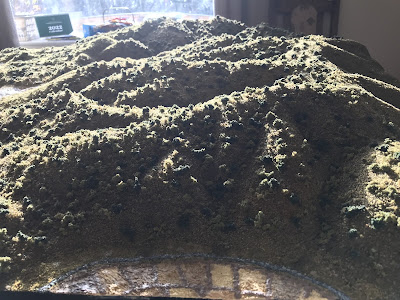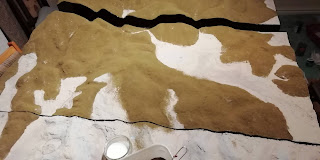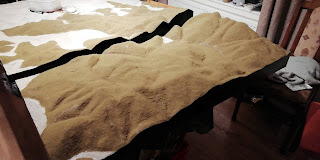I am nearing the end of my River Imjin board build, and having completed the flocking I have moved on to adding in the villages, roads, smaller rivers and streams as well as started on the paddy fields. There is more information on the earlier phases of the build starting here.
Roads were created by brushing on a thin line of PVA and then adding a really fine sand from war world gaming. A similar process was used for the minor rivers using a dark ash sand with some larger greyer grains using N gauge railway ballast. They are really dark but I haven’t quite finished with these rivers yet as I will be highlighting them with different colours once I am closer to the finish.
The Korean houses on the battlefield were mostly traditional hanok style, single storey, with wooden frames and dirt and straw walls with straw thatch on the roof. A small number were stone with tile roofs, belonging to richer or noble Koreans. They tended to be fairly small and were clustered into a number of villages. The area had already seen fighting during the war and some buildings had already been destroyed. They also tended to be located in the valleys. Consequently the villages and buildings had little military value or role in the battle.
Regular readers of this blog will know I see buildings as terrain and so try to represent them in as close to ground scale as possible. I am building the battlefield with a ground scale of 1:4000, or 1 mm equaling 4 metres. Consequently my ability to detail buildings was limited - and given there are hundreds on the battlefield this is a good thing! So I started with match sticks, which have a roughly 2mm square profile. They were too big. So I tried cutting them lengthways to get 1mm square blocks. I could do it but it was time consuming and wasteful. So I went online and found some lengths of 1mm and 1.5mm square wood from a modelling store. Who knew that was a thing? Progress speeded up thereafter.
Firstly I painted the wood a dark brown. For the higher status buildings I painted them white. Then I used my craft knife and cut the strips roughly into 2mm long pieces. Each individual building would therefore be about 4m wide, 4 m high and 8m long. All in all not too bad.
I used AK Terrains Diarama series light earth acrylic texture as a base for my villages. Once dry the buildings were then glued on using PVA.
I then gave the whole village a soft tone inkwash. I used a 0.3mm permanent marker to divide the village into small holdings.
I then painted random blocks with different greens or browns.
The tops of each village building was painted necrotic green and soft tone ink wash. The higher status buildings got a chaos red colour. I added a dash of tufts and my villages were done!
Then the hard slog began! Rice paddies, lots and lots and lots of them.
The terrain on this board generally is split between flat and steeply rising hills. Looking at a map of the area made in 1953 this shows that pretty much all the flat area was paddy fields. The paddy fields on this map were much more extensive than the ones shown on the 1951 map I used for the contours. However the 1953 map noted that most of the villages were “destroyed”. This seems counter-intuitive. Why would destroyed villages need more rice paddies? I think the answer lies in the 1951 map being based on 1940s Japanese maps. I believe that the rice paddies were developed during the mid to late 40’s and therefore most were present at the time of the battle in 1951. Thus I decided that pretty much any flat area on the board would have rice paddies on them.
The battle took place in late April and so the rice paddies at that time of year were not planted or flooded and so would have been bare and in various shades of brown. The image above shows a Google Earth image of the paddies on the Imjin during winter. This would be the basis for the colours and size of the rice paddies on the board.
To create mine I used AK terrain’s desert sand texture as a base.
I then used monster brown paint and a range of inks to create individual paddies.
I just kept adding them, randomly placing each colour .


















































